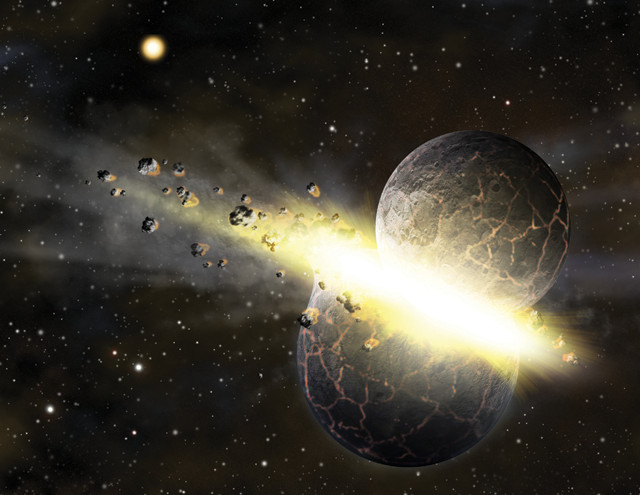
by Kate S. Zalzal Wednesday, January 18, 2017

Artist's conception of the violent impact that formed the moon. Credit: K. Cantner, AGI.
Scientists have long thought that the moon was formed when an impactor crashed into Earth, some 100 million years after the planet’s formation. But details of this collision, and how the moon formed in its aftermath, remain puzzling. Now, researchers have found new potassium isotopic evidence that suggests the moon condensed from a superheated cloud of Earth’s mantle material after an extremely violent collision vaporized the impactor and much of the proto-Earth.
The so-called giant impactor hypothesis, introduced in the 1970s, explains many of the physical attributes of our Earth-moon system. However, as analytical technology has improved, critical geochemical details in the original model were found to be inconsistent. For example, about 80 percent of the moon’s material should have come from the impactor. But nearly identical oxygen isotope values observed in Earth and moon rocks — which are composed of about 50 percent oxygen by mass — make this scenario highly unlikely, given that the impactor, and thus the moon, would almost certainly have had a different isotopic signature than Earth.
Given the similarity between oxygen isotope values on the moon and Earth, the moon must consist mostly of material derived from early Earth, rather than the impactor, says Kun Wang, a geochemist at Washington University in St. Louis and lead author of the new study, published in Nature. In recent years, scientists have proposed various models to account for this, but the mechanism of moon formation is different in each model.
“We wanted to test [these] theories given the geochemical constraints that we know,” Wang says. But critically missing from the geochemical understanding was how the moon and Earth differ with respect to potassium.
Potassium is abundant enough to measure, and fractionation of its isotopes reflects the evaporation and condensation that occurred during the moon-forming event, Wang says. “Potassium is at a sweet spot,” he adds. “It’s unique and useful because of its medium volatility.” Highly volatile elements, such as hydrogen, zinc and chlorine, are easily lost in an impact; less volatile elements, meanwhile, are more stable (and therefore less likely to fractionate), thus offering fewer clues about the processes that occurred during moon formation.
Wang and his co-author, Stein Jacobsen of Harvard, measured and compared potassium isotope concentrations from seven lunar rock samples obtained during Apollo missions and eight Earth rock samples from different tectonic regions. The study, for the first time, shows that the potassium isotope concentrations of the lunar rocks are significantly enriched in heavy potassium-41 compared to those from Earth.
The difference in potassium “places a strong quantitative constraint on the possible mechanisms that led to a lunar origin,” says Sarah Stewart, a geophysicist at the University of California, Davis, who was not involved in the study. So, the researchers behind the new study “can rule out some of the proposed models.”
Wang and Jacobsen applied their data to the two leading models of the moon’s origin that accommodate the identical oxygen isotope signatures between the two bodies. In one scenario, a relatively low-energy, perhaps grazing, impact creates a cloud of crustal debris — a silicate-atmosphere — from which Earth and the newly forming moon exchange a limited amount of mantle material as they coalesce. This model predicts zero, or even negative, enrichment of potassium-41 in lunar rocks compared to Earth rocks.
In the second scenario, the impact is so violent that it blasts apart the proto-Earth, vaporizing much of Earth’s mantle as well as the impactor. The resulting well-mixed mass of magma forms a mantle-atmosphere that extends into space, providing a pool of homogenous building material from which the moon and Earth then coalesce. This model predicts that lunar rocks would initially have the same potassium isotopic values as Earth rocks. However, as the moon cooled and condensed over time out of the mantle-vapor, lunar material would have become concentrated in heavy potassium-41 relative to Earth — which is consistent with Wang and Jacobsen’s observations.
This work provides the first hard evidence that the impact largely vaporized Earth, Wang says.
If additional data in the future don’t work with this model, the model will need to be refined further, he adds. But for now, the mantle-atmosphere model “explains everything we can observe so far: the size, the location, the orbital data — all the astrophysical and geochemical features of the moon.”
© 2008-2021. All rights reserved. Any copying, redistribution or retransmission of any of the contents of this service without the expressed written permission of the American Geosciences Institute is expressly prohibited. Click here for all copyright requests.